
Mycteroperca bonaci, the black grouper, black rockfish or marbled rockfish, is a species of marine ray-finned fish, a grouper from the subfamily Epinephelinae which is part of the family Serranidae, which also includes the anthias and sea basses. Other fish are sometimes called the black grouper including the similar gag grouper, the misty grouper, and the warsaw grouper. This species is found in the western Atlantic Ocean from the northeastern United States to Brazil.
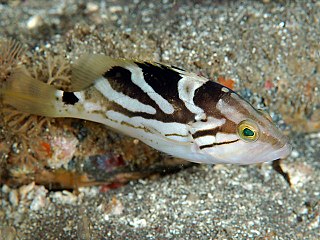
The comet grouper, also known as the comet cod or dot-dash grouper, is a species of marine ray-finned fish, a grouper from the subfamily Epinephelinae which is part of the family Serranidae, which also includes the anthias and sea basses. It is a species of deep coral reefs in the Indo-Pacific region.

The marbled grouper, donkey fish, mutton hamlet, rockhind and sicklefish grouper, is a species of marine ray-finned fish, a grouper from the subfamily Epinephelinae which is part of the family Serranidae, which also includes the anthias and sea basses. It is a predatory reef fish which is found in the Western Atlantic Ocean.

The smooth grouper is a species of marine ray-finned fish, a grouper from the subfamily Epinephelinae which is part of the family Serranidae, which also includes the anthias and sea basses. It is associated with reefs and is found in the western Indian Ocean.
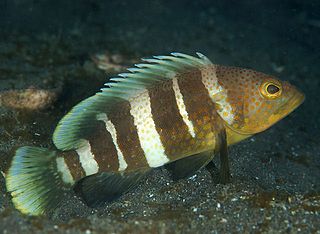
The yellow grouper, also known as the banded grouper, is a species of marine ray-finned fish, a grouper from the subfamily Epinephelinae which is part of the family Serranidae, which also includes the anthias and sea basses. It is found in eastern Asian waters of the Western Pacific Ocean. Its natural habitats are shallow seas and rocky reefs.

The snowy grouper is a species of marine ray-finned fish, a grouper from the subfamily Epinephelinae which is part of the family Serranidae, which also includes the anthias and sea basses. It is found in the western Atlantic Ocean.
The Venezuelan grouper is a species of marine ray-finned fish, a grouper from the subfamily Epinephelinae which is part of the family Serranidae, which also includes the anthias and sea basses. It is found in northern South America and the Greater Antilles.

Mycteroperca is a genus of marine ray-finned fish, groupers from the subfamily Epinephelinae, part of the family Serranidae, which also includes the anthias and sea basses. They are predatory fish, largely associated with reefs and are found in tropical and subtropical seas in the Atlantic Ocean and the eastern Pacific Ocean. They are important target species for fisheries.

The mottled grouper is a species of marine ray-finned fish, a grouper from the subfamily Epinephelinae which is part of the family Serranidae, which also includes the anthias and sea basses. It is found in the eastern Atlantic Ocean and the Mediterranean Sea.

The tiger grouper is a species of marine ray-finned fish, a grouper from the subfamily Epinephelinae which is part of the family Serranidae, which also includes the anthias and sea basses. It is found in the warmer waters of the western Atlantic Ocean.
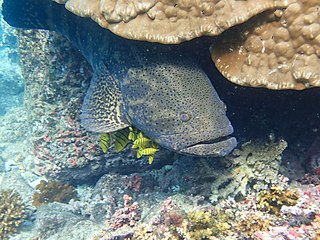
The Pacific goliath grouper, also known as the Pacific itajara grouper, is a species of marine ray-finned fish, a grouper from the subfamily Epinephelinae which is part of the family Serranidae, which also includes the anthias and sea basses. It is found in the eastern Pacific Ocean where it is associated with reefs. It is related to the Atlantic goliath grouper.

Cephalopholis panamensis, the Pacific graysby or Panama graysby, is a species of marine ray-finned fish, a grouper from the subfamily Epinephelinae which is in the family Serranidae which also includes the anthias and sea basses. It is found in the Eastern Pacific Ocean.
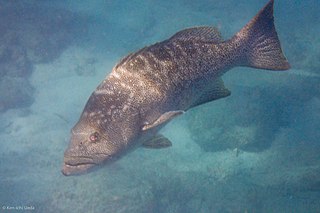
Mycteroperca rosacea, the leopard grouper or golden grouper, is a species of marine ray-finned fish, a grouper from the subfamily Epinephelinae which is part of the family Serranidae, which also includes the anthias and sea basses. It is found in the Eastern Central Pacific that occasionally makes its way into the aquarium trade.
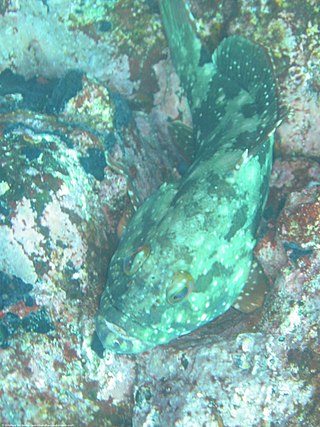
Epinephelus labriformis, commonly called starry grouper or flag cabrilla is a species of marine ray-finned fish, a grouper from the subfamily Epinephelinae which is part of the family Serranidae, which also includes the anthias and sea basses. It is found in the eastern Pacific Ocean.

Cephalopholis sexmaculata, sixblotch hind, freckled cod, freckled rock-cod, sixband cod, six-banded rockcod, sixband rockcod or sixspot rockcod is a species of marine ray-finned fish, a grouper from the subfamily Epinephelinae which is in the family Serranidae which also includes the anthias and sea basses. This fish occurs throughout the Indo-Pacific region.

Epinephelus erythrurus, the cloudy grouper, also known as the cloudy rock cod, is a species of marine ray-finned fish, a grouper from the subfamily Epinephelinae which is part of the family Serranidae, which also includes the anthias and sea basses. It is found in marine and brackish waters in the Indo-Pacific region.

Epinephelus latifasciatus, the striped grouper, banded grouper or spotfin rockcod, is a species of marine ray-finned fish, a grouper from the subfamily Epinephelinae which is part of the family Serranidae, which also includes the anthias and sea basses. It is found in the Indo-Pacific region.

Epinephelus sexfasciatus, the sixbar grouper, sixbar rockcod or six-banded rockcod, is a species of marine ray-finned fish, a grouper from the subfamily Epinephelinae which is part of the family Serranidae, which also includes the anthias and sea basses. It is found in the Indo-Pacific region.

Hyporthodus mystacinus, the misty grouper, black grouper, convict grouper, eightbar grouper or moustache grouper, is a species of marine ray-finned fish, a grouper from the subfamily Epinephelinae which is part of the family Serranidae, which also includes the anthias and sea basses. It is primarily found in the Caribbean and the Gulf of Mexico with populations present around the Galapagos Islands and Central American coastlines.

Cephalopholis sonnerati, known as the tomato hind, tomato rockcod, or tomato cod, is a species of marine ray-finned fish, a grouper from the subfamily Epinephelinae which is in the family Serranidae which also includes the anthias and sea basses. It is distributed on coral reefs in the tropical Indo-Pacific. It is also sometimes called the orange-spotted cod, red coral cod, red rockcod, tomato grouper, or tomato seabass.




















